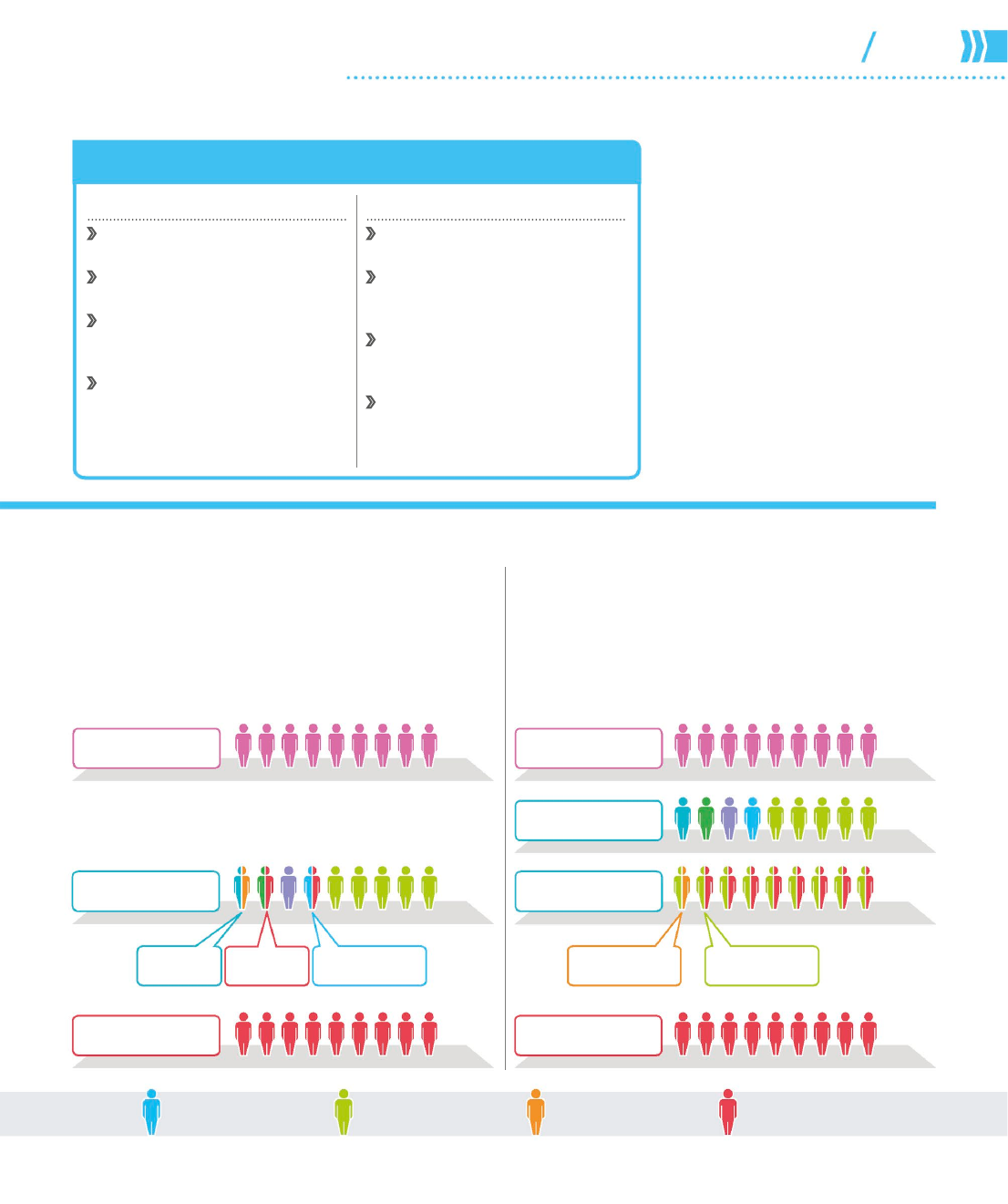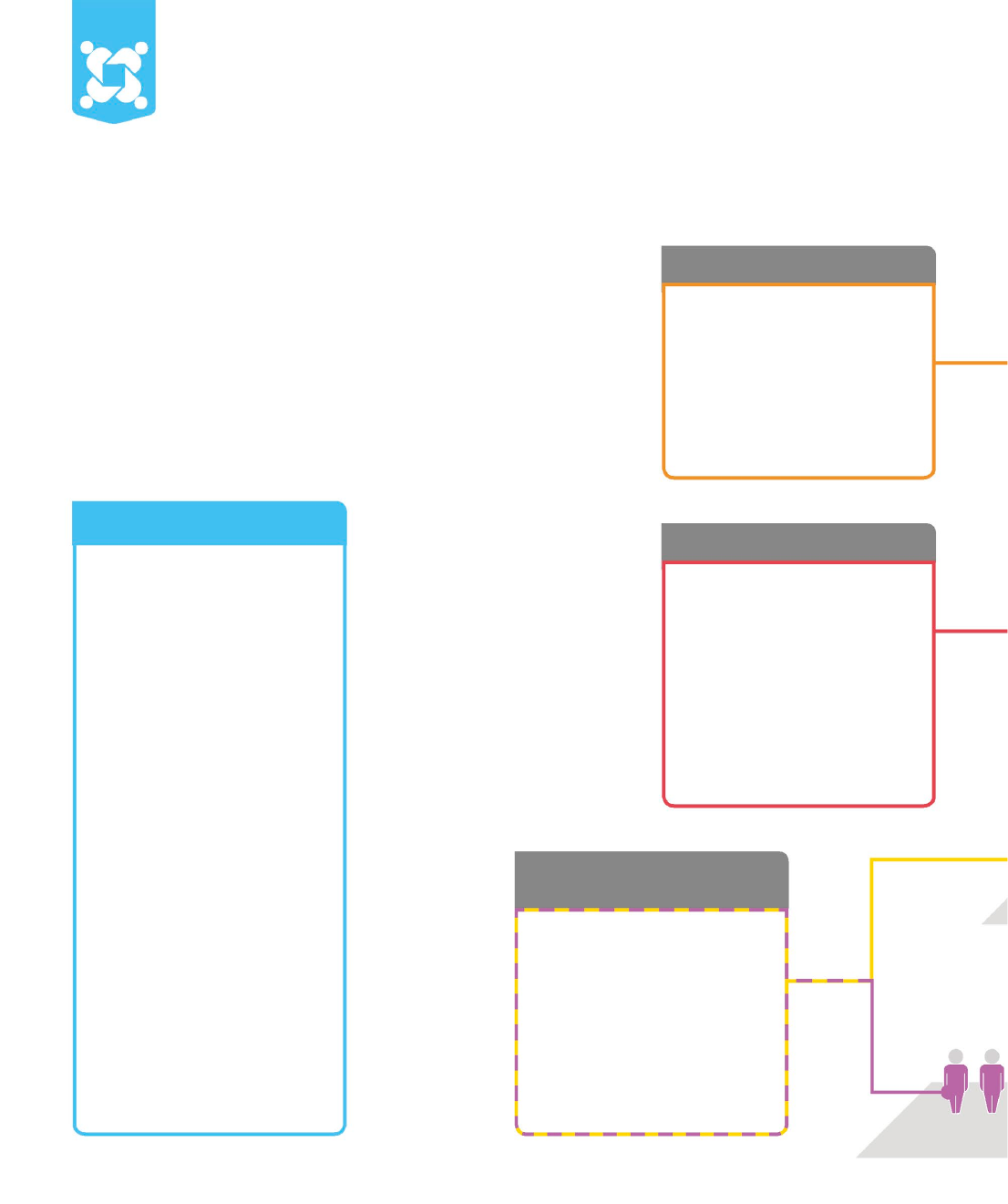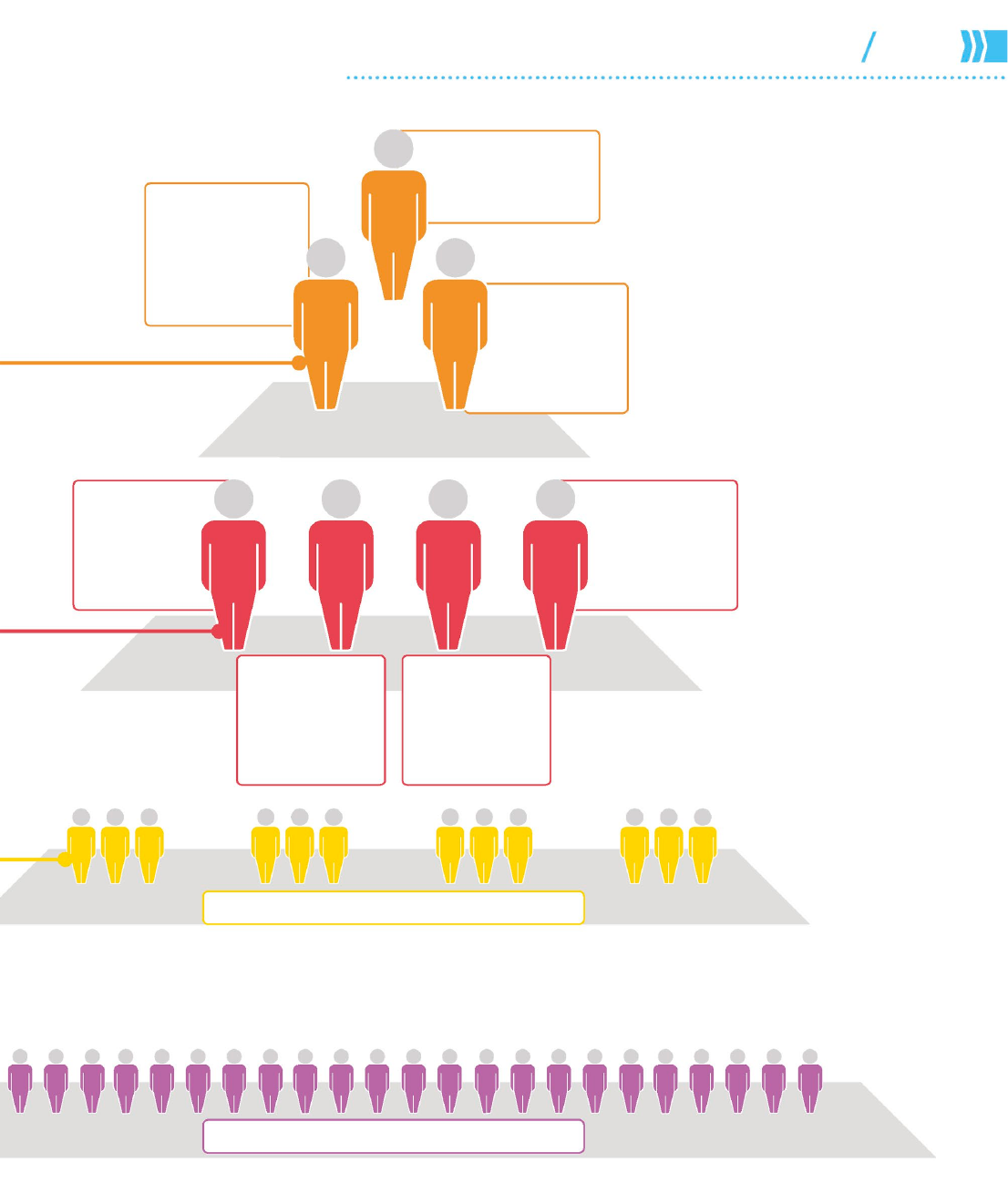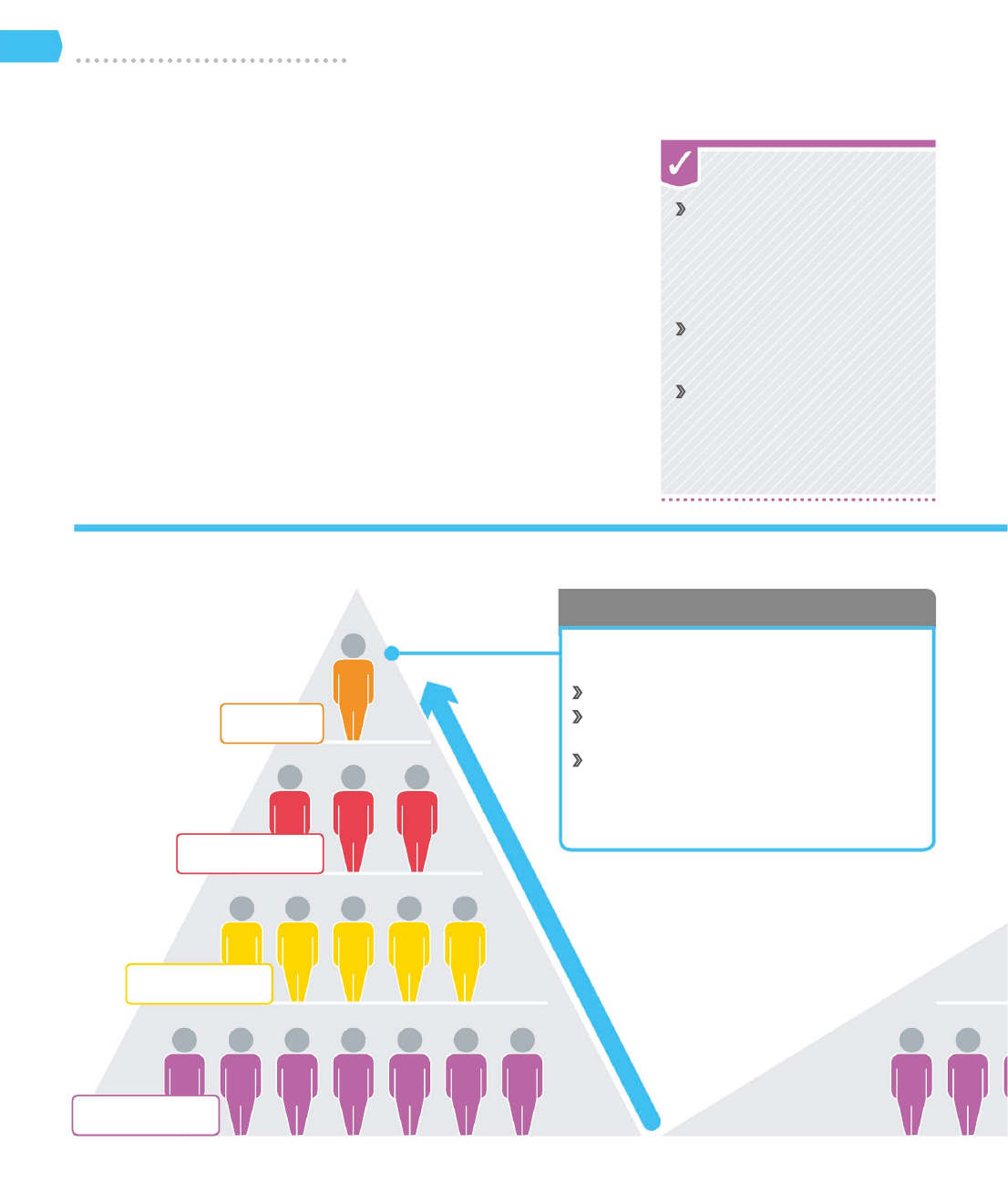
54 55
how companies work
Who’s who
Two-tier board
An arrangement that is made up of separate supervisory
and executive boards. The supervisory board is composed
of outside directors, led by a chairman. The executive
board comprises senior managers, including the CEO.
The two boards always meet separately.
Senior management as directors
A structure in which senior managers also sit on the board.
The chief financial officer (CFO) is appointed board treasurer
and the chief operations officer (COO) is vice-chairman. In
some countries (Germany, for example), employees must
be included on the board by law.
Board of directors
Supervisory board
Executive board
Management and
employees
Management and
employees
Shareholders Shareholders
Treasurer
and CFO
Vice-chairman
and COO
Chairman
and CEO
44%
of S&P 500-listed
companies had
distinct CEO and
chairman roles in
2012—up from
21% in 2001
Management and employees
CEO
Vice-chairman Other directors
CEO and board
member
Employee and
board member
PROS AND CONS OF CEO AS CHAIRMAN
Pros
Strong, central leadership
Decisions hold fewer conflicts.
Efficiency CEO/chairman can
implement board decisions swiftly.
Expertise CEO has company and
industry knowledge (a CEO may
become chairman after retirement).
Balance of power Established
hierarchy between CEO/chairman
and other directors reduces risk
of conflict on the board.
Cons
Lack of transparency Conflicts of
interest/corruption are more likely.
Reduced objectivity Board
headed by CEO is unable to monitor
CEO’s work objectively.
Higher remuneration Combined
role generally commands higher pay
than two separate individuals.
Mentoring Chairman who is
also CEO cannot offer independent
mentoring and support for the role.
US_052-055_Board_of_directors.indd 55 21/11/2014 16:38

How it works
There are five levels in the
conventional corporate structure
with a line of authority from top to
bottom. The chief executive officer
(CEO) is the highest-ranking person
in the company, reporting to the
board of directors and sometimes
also sitting on the board. Reporting
to the CEO are a number of high-
level executives, known as C-level
Company hierarchy
executives—their job titles begin
with a “C” and end with an “O.”
Below the C-level is management,
in tiers that differ from company to
company, with employees forming
the bottom level. As well as skilled
and unskilled employees, there may
be staff on fixed-term contracts,
taken on for the duration of a
project or for a set length of time,
and casual temporary workers.
Almost every organization has a structured arrangement of levels for
members, from the board of directors at the top to junior employees at
the bottom. There is a trend toward reducing the number of levels.
These are the most senior jobs in
the company, with the CEO at the
top, the COO and CFO traditionally
on the next level down, and other
C-positions below that. In many
companies, the C-level positions
have equal authority and all report
directly to the CEO.
C-suite executives
Responsible for overseeing specific
functions in the organization, the
most senior managers at this level
head up different departments or
divisions. These managers are often
called directors (not to be confused
with the board of directors) or, in
the US, vice-presidents. The exact
job titles, and the number of mid-
level managers, vary depending
on the company.
Mid-level management
C-LEVEL VARIATIONS
The range of C-level positions varies
for each company. In addition to
the three top posts, there may be:
CAO Chief Administrative Officer
CIO Chief Information Officer
CTO Chief Technology Officer
CPO Chief Product/Production
Officer, responsible for overseeing
product development and
production
CMO Chief Marketing Officer,
responsible for marketing strategy
and business development
C-level positions are evolving,
adapting to market conditions and
business priorities. New roles are
emerging while some traditional
roles are disappearing. The role of
COO, for example, is less popular
in modern organizations. Some of
the new roles include:
CPO Chief Privacy Officer
CSO Chief Sustainability Officer
CDO Chief Digital Officer
CKO Chief Knowledge Officer
CCO Chief Customer Officer
51%
of CIOs and CTOs
say they are
pioneering new
digital approaches
within their
business
Team leaders, such as supervisors
and assistant managers, implement
management plans. They also
coordinate teams of skilled and
unskilled workers in, for example,
production, customer service,
and sales to carry out the core
tasks needed for the company to
function efficiently and profitably.
Junior management
and other employees
US_056-059_Company_Hierachy.indd 56 21/11/2014 16:38
56 57
how companies work
Who’s who
CHIEF FINANCIAL
OFFICER (CFO)
Manages company’s
financial risk;
reports to CEO
CHIEF EXECUTIVE
OFFICER (CEO)
Decides on corporate
policy and strategy
CHIEF OPERATING
OFFICER (COO)
Responsible for
day-to-day operations;
reports to CEO and
acts as second
in command
MARKETING
MANAGER
Directs marketing
department
day to day
OPERATIONS
MANAGER
Oversees operations
division; may also
direct production
department
R AND D
MANAGER
Heads up research
and development
(R and D) of new
products
FINANCE
MANAGER
Puts CFO’s plans or
directions into
action, instructing
junior managers
SUPERVISORS AND TEAM LEADERS
NON-MANAGEMENT EMPLOYEES
15%
the average salary
rise for a C-level
executive reporting
to the CEO, in the
US between 1986
and 2006
US_056-059_Company_Hierachy.indd 57 21/11/2014 16:38

56 57
how companies work
Who’s who
CHIEF FINANCIAL
OFFICER (CFO)
Manages company’s
financial risk;
reports to CEO
CHIEF EXECUTIVE
OFFICER (CEO)
Decides on corporate
policy and strategy
CHIEF OPERATING
OFFICER (COO)
Responsible for
day-to-day operations;
reports to CEO and
acts as second
in command
MARKETING
MANAGER
Directs marketing
department
day to day
OPERATIONS
MANAGER
Oversees operations
division; may also
direct production
department
R AND D
MANAGER
Heads up research
and development
(R and D) of new
products
FINANCE
MANAGER
Puts CFO’s plans or
directions into
action, instructing
junior managers
SUPERVISORS AND TEAM LEADERS
NON-MANAGEMENT EMPLOYEES
15%
the average salary
rise for a C-level
executive reporting
to the CEO, in the
US between 1986
and 2006
US_056-059_Company_Hierachy.indd 57 21/11/2014 16:38

COMPANY HIERARCHY
Flattening hierarchies
The trend in management over
the past few decades has been to
eliminate layers from company
hierarchies, which means they are
becoming flatter—in other words,
there are not as many levels to go
through in order to reach the top.
One example is the role of chief
operating officer (COO), which has
been disappearing in recent years.
Between 2000 and 2012, there was
a 10 percent decline in the number
of Fortune 500 (an annual list of
the top US corporations compiled
by Fortune magazine) companies
with COOs. Only 38 percent of the
500 have a COO position now.
CEOs have also eliminated layers
of middle management, and in
the US there was a 300 percent
increase between 1986 and 2003
in the number of division heads
reporting directly to the CEO.
Sometimes companies decide
restructure the other way round
instead —from flat to tall—by
eliminating a number of senior
management posts and replacing
them with a greater number of
junior supervisory roles.
Tall vs. flat hierarchies
There are pros and cons for both
types of hierarchy, and each
company has to find the
number of levels, and
positions within each
level, that suits the
nature of its
business.
CHAIN OF COMMAND
Span of control Number
of employees reporting to a
manager or other senior level;
the greater the span of control,
the more workers reporting to
an individual above
Line position Job role with
responsibility for achieving the
goals of the organization
Staff position Job role providing
expertise to assist someone in a
line position
NEED TO KNOW
The traditional model is suitable for a formal
chain of command as, for example, in the army.
Several layers from top to bottom
Fewer employees reporting to each manager;
close supervision possible
More room for career advancement because
there are many levels to rise through
Tall hierarchy
CEO
Mid-level
management
Supervisors and
team leaders
Non-management
employees
US_056-059_Company_Hierachy.indd 58 15/12/2014 12:55
58 59
how companies work
Who’s who
Restructuring the big three US car manufacturers
CASE STUDY
25%
the decline in the
levels of hierarchy
between division
heads and CEOs
in the US, from
1986 to 2003
The economic crisis of 2008 caused
the big three American car-making
companies—General Motors (GM),
Ford, and Chrysler—to rethink their
corporate structures. Market share
had fallen and the three companies
needed to shed employees and find
ways to cut production.
All three took similar action to
reorganize the company hierarchy,
removing some managerial roles
from the mid-management level
and installing more team leaders
at a lower level in the organization
to create a flatter, less top-heavy
company hierarchy.
Before restructuring Thirty
technicians reported to one
production supervisor.
After restructuring Seventy-five
technicians now reported to one
production supervisor, through 18
newly created team leader positions.
This looser model is more flexible and suitable for
companies that foster creativity.
Only a few layers so mid- and low-level
management are merged
Large number of employees reporting to each
manager; close supervision not possible
More freedom for employees to make their
own decisions
Flat hierarchy
Supervisors and
team leaders
Non-management
employees
CEO
CHAIN OF COMMAND
US_056-059_Company_Hierachy.indd 59 15/12/2014 12:55

58 59
how companies work
Who’s who
Restructuring the big three US car manufacturers
CASE STUDY
25%
the decline in the
levels of hierarchy
between division
heads and CEOs
in the US, from
1986 to 2003
The economic crisis of 2008 caused
the big three American car-making
companies—General Motors (GM),
Ford, and Chrysler—to rethink their
corporate structures. Market share
had fallen and the three companies
needed to shed employees and find
ways to cut production.
All three took similar action to
reorganize the company hierarchy,
removing some managerial roles
from the mid-management level
and installing more team leaders
at a lower level in the organization
to create a flatter, less top-heavy
company hierarchy.
Before restructuring Thirty
technicians reported to one
production supervisor.
After restructuring Seventy-five
technicians now reported to one
production supervisor, through 18
newly created team leader positions.
This looser model is more flexible and suitable for
companies that foster creativity.
Only a few layers so mid- and low-level
management are merged
Large number of employees reporting to each
manager; close supervision not possible
More freedom for employees to make their
own decisions
Flat hierarchy
Supervisors and
team leaders
Non-management
employees
CEO
CHAIN OF COMMAND
US_056-059_Company_Hierachy.indd 59 15/12/2014 12:55
..................Content has been hidden....................
You can't read the all page of ebook, please click here login for view all page.
